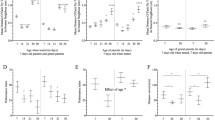Abstract
In an investigation into the effects of developmental isolation from all conspecifics, the Drosophila willistoni group of six sibling species responded to differing degrees: all six are reproductively isolated from D. paulistorum, the tester species. Drosophila pavlovskiana, a narrow endemic, proved the most vulnerable, responding by reducing its adult sexual isolation, if eggs, any instar, and sometimes even pupae were socially isolated. To lesser degrees, D. tropicalis and D. willistoni both produced similar results only when their eggs were isolated, i.e., when from the moment of egg deposition on, there was absolutely no contact with other flies until testing for mating behavior. The remaining siblings, D. equinoxialis and D. insularis, were immovable.
Similar content being viewed by others
REFERENCES
Bateman, A. J. (1949). Analysis of data on sexual isolation. Evolution 3:174–177.
Dobzhansky, Th., and Powell, J. R. (1975). The willistoni group of sibling species of Drosophila. In King, R. C. (ed.), Handbook of Genetics, Vol. 3, Plenum, New York, pp. 589–622.
Ehrman, L. (1975). Reproductive isolation in Drosophila. In Price, E. O. (ed.), Animal Behavior in Laboratory and Field, 2nd ed., W. H. Freeman, San Francisco, pp. 71–74, and Teachers Manual, pp. 35-36.
Ehrman, L., and Parsons, P. (1981). The Genetics of Behavior, Sinauer, Sunderland, MA.
Ehrman, L., and Powell, J. R. (1982). The Drosophila willistoni, species group. In Ashburner, M., Carson, H. L., and Thompson, J. N., Jr. (eds.), The Genetics and Biology of Drosophila, Vol. 3b, Academic Press, New York, pp. 193–225.
Elens, A. A., and Wattiaux, J. M. (1964). Direct observation of sexual isolation. Dros. Info. Serv. 39:118–119.
Kim, Y.-K., and Ehrman, L. (1998). Developmental isolation and subsequent adult behavior of Drosophila paulistorum. IV. Courtship. Behav. Genet. 28:57–65.
Kim, Y.-K., Ehrman, L., and Koepfer, H. R. (1992). Developmental isolation and subsequent adult behavior of Drosophila paulistorum. I. Survey of the six semispecies. Behav. Genet. 22: 545–556.
Kim, Y.-K., Ehrman, L., and Koepfer, H. R. (1996a). Developmental isolation and subsequent adult behavior of Drosophila paulistorum. II. Prior experience. Behav. Genet. 26:15–25.
Kim, Y.-K., Koepfer, H. R., and Ehrman, L. (1996b). Developmental isolation and subsequent adult behavior of Drosophila paulistorum. III. Alternative rearing. Behav. Genet. 26:27–37.
Lambert, D. M., and Spencer, H. G. (1995). Speciation and the Recognition Concept: Theory and Applications, Johns Hopkins University Press, Baltimore.
Manning, A. (1959). The sexual isolation between Drosophila melanogaster and Drosophila simulans. Anim. Behav. 7:60—65.
Manning, A. (1965). Drosophila and the evolution of behavior. In Carthy, J., and Duddington, C. (eds.), Viewpoints in Biology, Butterworth, London, pp. 125–169.
Paterson, H. E. H. (1985). The recognition concept of species. In Vrba, E. S. (ed.), Species and Speciation, Transvaal Museum Monograph No. 4, Transvaal Museum, Pretoria, pp. 21–29.
Paterson, H. E. H. (1993). Evolution and the Recognition Concept of Species: Collected Writings, Johns Hopkins University Press, Baltimore.
Petit, C., and Ehrman, L. (1969). Sexual selection in Drosophila. In Dobzhansky, Th., Hecht, M. K., and Steer, W. C. (eds.), Evolutionary Biology, Vol. 3, Appleton-Century-Crofts, New York, pp. 177–217.
SAS Institute Inc. (1991). SAS/STAT User's Guide, Version 6.03, SAS Institute Inc., Cary, NC.
Sokal, R. R., and Rohlf, F. J. (1981). Biometry, W. H. Freeman, San Francisco.
Spassky, B. (1957). Morphological differences between sibling species of Drosophila. Stud. Drosophila Genet. Univ. Tex. Publ. 5721:48–61.
Spiess, E. B. (1987). Discrimination among prospective mates in Drosophila. In Fletcher, D. J. C., and Michener, C. D. (eds.), Kin Recognition in Animals, John Wiley & Sons, New York, pp. 75–119.
Author information
Authors and Affiliations
Rights and permissions
About this article
Cite this article
Kim, YK., Ehrman, L. Developmental Isolation and Subsequent Adult Behavior of Drosophila paulistorum. V. Survey of Six Sibling Species. Behav Genet 29, 65–73 (1999). https://doi.org/10.1023/A:1021494023660
Issue Date:
DOI: https://doi.org/10.1023/A:1021494023660




